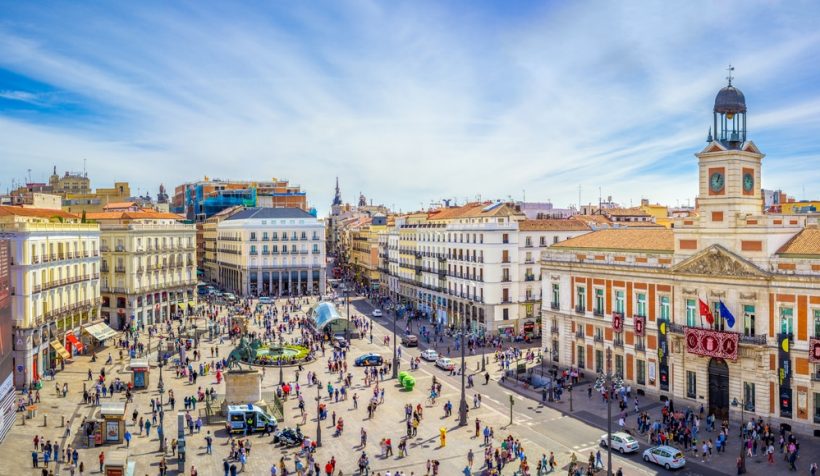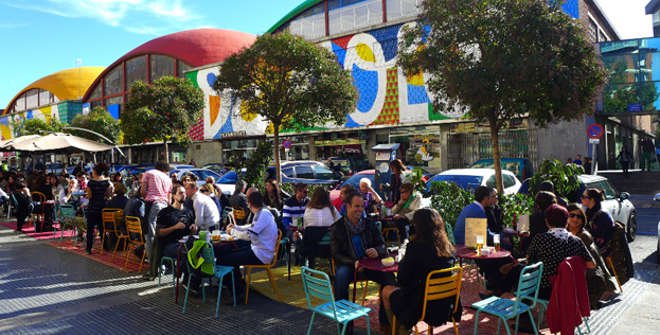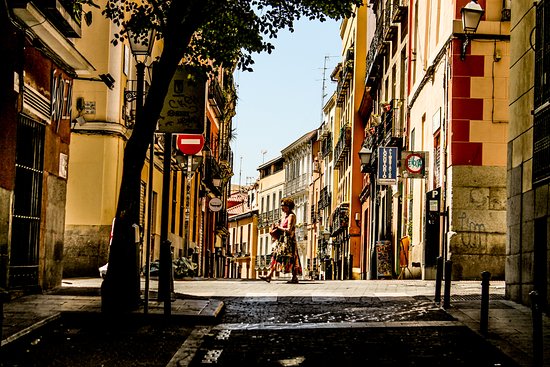Независимо от того , кто вы и что вы любите, есть Мадрид район , который заставит вас чувствовать себя как дома. От шикарных, современных торговых гаваней до красочных улиц с международной атмосферой, каждый из столичных Барриосов предлагает свой собственный уникальный аромат.
Вот 10 из лучших Мадрид окрестностей стоит исследовать. Выберите один в качестве главной базы во время Вашего пребывания в испанской столице, но не забудьте проверить остальные, как вы исследовать город, тоже.
золь

Если вы знаете что-нибудь о Мадрид уже, это то, что символическая площадь Пуэрта-дель-Соль является одним из самых больших города привлекает. Он должен прийти, как не удивительно, то, что окружающая область, которая также называется Соль-самое происходит соседство испанской столицы.
Там есть много, чтобы увидеть и сделать в этой области, так что вы никогда не будете скучать, но цены на жилье могут быть на высокой стороне. Он также имеет тенденцию чувствовать себя более заселена туристами, а не местные жители.
Chueca

Known in English-speaking circles as Madrid’s unofficial “gayborhood,” Chueca is home to a thriving LGBT community. Its welcoming atmosphere means that anyone who ventures through here will immediately feel at home.
Chueca offers great boutique shopping, an impressive assortment of small museums, and plenty of tapas bars in addition to a great nightlife scene. Located just north of Gran Vía, its location in the heart of Madrid couldn’t be more perfect.
Malasaña

Head a little ways west of Chueca and you’ll hit Malasaña, another one of Madrid’s most vibrant and exciting neighborhoods. It’s one of the city’s best areas for nightlife, as well as a popular barrio of choice for Spanish and foreign young people.
Despite its modernity, Malasaña still has a rich history worth exploring. Its main square, Plaza Dos de Mayo, was the site of an epic battle in which madrileños defeated Napoleon’s forces on May 2, 1808. Today, the plaza is one of Madrid’s most-visited thanks to its status as an al fresco dining hotspot.
Salamanca

Not to be confused with the nearby city of the same name, Madrid’s Salamanca neighborhood is a shopper’s paradise. The area’s wide, gleaming avenues are home to major international fashion brands, from high-end top designers to more affordable household names.
Despite being undeniably upscale and chic, Salamanca is, at its heart, a residential neighborhood. Here, you’ll find local families going about their everyday lives in a way that’s hard to scope out in the more tourist-heavy city center.
La Latina

Foodies, this one’s for you. There is arguably no better place for a tapas crawl in Madrid than La Latina, particularly the iconic street Calle Cava Baja. You could easily spend an entire afternoon or evening simply eating your way through each of the fabulous tapas bars that line the street and still have plenty of places left to hit.
The neighborhood itself is at once both traditional and modern, combining a classic Spanish vibe with a touch of hipster, bohemian flair. Its myriad picturesque plazas are perfect for sitting and enjoying a cup of coffee while reading a good book or people-watching.
Lavapiés

Part of what makes Madrid so great is its thriving immigrant community, a large part of which lives in the Lavapiés district. International influences can be seen everywhere, particularly in the neighborhood’s diverse array of multicultural restaurants (making this a great destination if you’re looking for something beyond typical Spanish fare).
Lavapiés feels a bit more gritty and rugged than some of the other Madrid neighborhoods listed here, but that’s not necessarily a bad thing. Its staunch resistance towards gentrification makes it one of the city’s last remaining neighborhoods where you can truly get a sense of how locals live.
Huertas/Barrio de las Letras

Known by either of two names—Huertas after its main street and Barrio de las Letras (the Literary Quarter) as a nod to its past—this neighborhood just about has it all. It’s centrally located, but doesn’t draw as many tourists as nearby Sol, and is steeped in history and charm, making it one of Madrid’s most picturesque areas.
The area gets its name thanks to the countless literary minds who lived and worked in the area throughout the centuries. In fact, the house where Spanish author Miguel de Cervantes (of “Don Quijote” fame) died remains one of the neighborhood’s most interesting historical sights.
Moncloa/Argüelles

Another area that is referred to locally by two names, the neighborhood known as Argüelles or Moncloa is situated west of the city center. But that doesn’t mean it’s far from the action—quite the opposite, actually. The area is home to some of the Spanish capital’s biggest draws, such as the Royal Palace and the Temple of Debod.
Aside from its main attractions, the neighborhood remains a generally quiet, friendly place, particularly popular among young people and families. It also offers some beautiful parks (including easy access to the sprawling Casa de Campo green space) and an under-the-radar dining scene that could give some of Madrid’s better-known barrios a run for their money.
Retiro

If the name Retiro sounds familiar, it’s likely because Madrid’s most famous park of the same name has come to mind. But the area surrounding this lovely green space is worth checking out as well.
Many tourists who visit the park don’t generally head east of it into the Retiro neighborhood itself, and they’re missing out. This quiet residential area is one of Madrid’s most charming. It’s here where you’ll find some of the most delicious and authentic tapas in town, at emblematic neighborhood bars where you can rub elbows with locals while you eat.
Chamberí

Sandwiched between Moncloa and Salamanca, Chamberí is a residential and business district that hasn’t changed much over the years—and that’s a good thing. If living like a local and getting off the tourist-beaten path is what you’re after, this is the place for you.
Chamberí offers several lovely plazas where you can enjoy drinks or a meal, and its well-groomed streets are perfect for a relaxing walk away from the hustle and bustle of the city center. If offbeat sights are of interest, check out the formerly abandoned Chamberí metro station, which has since been restored to its former glory from the 1920s and allows visitors to experience what public transportation in Madrid was like in the past.